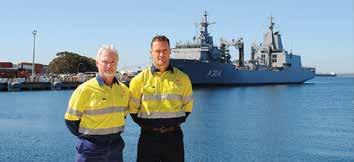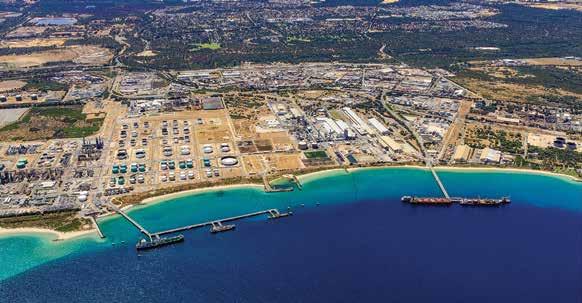
28 minute read
WESTPORT: FUTURE PROOFING AN INTEGRAL LINK
By Patrick Seares, Managing Director, Westport Program
Although isolated from the east coast, Western Australia is an integral link in Australia’s maritime operations and trade, playing an important role in global supply chains and ensuring the nation’s trade connections.
GLOBAL STANDARD PORT
The WA state government is preparing for the future through a number of related strategic priorities, including: Westport, a commitment to establish a Global Advanced Manufacturing Hub, and planning for the future of Fremantle.
A key piece of this work is the development of WA’s future container port through the Westport project. Planning is currently underway to develop a business case to move container trade from Fremantle’s inner harbour to a new outer harbour in Kwinana. The aim of this is to ease freight congestion and boost WA’s economic growth by maintaining efficient trade, and delivering local jobs and commercial opportunities.
It’s also a unique opportunity to develop a global standard port that is aligned with a range of WA industry sectors, including defence. Detailed planning is an integral first step to ensure this alignment. The Westport project is considering a range of needs and solutions through meaningful stakeholder engagement, including relationships with program partners across government and industry. This will ensure requirements can be appropriately integrated into the project as it progresses.
As the Westport program focuses on completing a business case by mid-2024, early planning is underway to identify the constraints, considerations and opportunities for the new outer harbour once an investment decision is made. This includes geotechnical investigations for channel designs that support navigational ease for the container vessels of the future, and a breakwater assessment to develop a design that will protect the harbour, channels and the broader Cockburn Sound environment.
Planning is currently underway to develop a business case to move container trade from Fremantle’s inner harbour to a new outer harbour in Kwinana. The aim of this is to unlock freight congestion and boost WA’s economic growth by maintaining efficient trade, and delivering local jobs and commercial opportunities.
SUPPLY CHAIN & ENVIRONMENTAL CONSIDERATIONS
With the preferred freight route determined, connecting to the future port will require significant upgrades to ensure an efficient and cost-effective supply chain. Over the next few years, transport and infrastructure upgrades in the Kwinana area will enable the Westport program. This long-term forward planning is particularly important to ensure that the
Westport Overview Map

most critical utility infrastructure located in that part of the state can be protected or relocated.
Delivery of a new outer harbour also requires the careful environmental consideration of Cockburn Sound. In response to this, the state is investing in one of the largest environmental research programs, and undertaking monitoring to ensure Cockburn Sound’s environment, recreation and indigenous cultural history are well understood. Westport is partnering with the Western Australian Marine Science Institution to manage and minimise impacts for the long-term integrity of this unique ecosystem.
The Westport program forms an integral part of ensuring WA embraces technology advancements, and aligns with WA government’s strategic priorities to deliver local jobs and facilitate economic development.

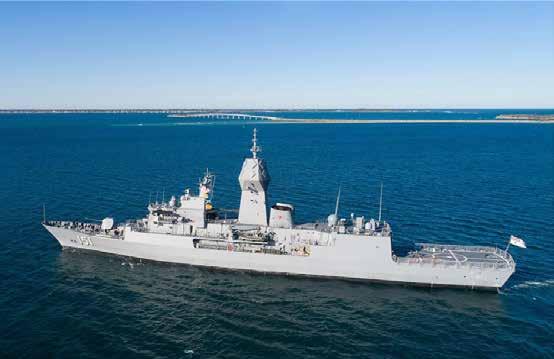
PRECISION NAVAL INSTALLATIONS
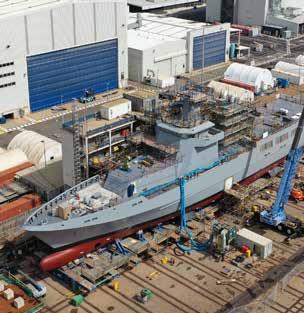
Partner with Australia’s most reputable Naval fleet electrical installation, repair and maintenance company.
Marine Technicians Australia (MTA) has an impeccable reputation for technical excellence and service, providing a range of maritime electrical solutions.
Australian owned and operated, MTA’s facilities in Sydney, Perth and Adelaide, are comprehensive and leading edge with full product, equipment and testing capabilities. Our extensive range of services to the Naval Maritime sector includes;
• Installation of all types of Power and
Signal Cable Types
• Termination and Testing of Power, Signal,
COAX and Fibre Cables (Including MILSPEC)
• Installation of Electrical Fixtures and Fittings
• Installation and Set to work of Communication and
Antenna Systems, Navigational Systems, Combat
System Equipment, Main Broadcast and Alarms
Systems, Automation and Control Systems, Gas
Detection Systems and Weapon System Hardware
• Conduct Generator Load Trials
• Maintenance and Urgent Defect Repair
• OEM Equipment Installation and Support
Contact us to discuss your next project and experience the benefits of partnering with MTA.
www.marinetechniciansaustralia.com.au PER // ADL // SYD

By Chris Oughton,
CEO, Kwinana Industries Council
VALUE OF THE WESTERN TRADE COAST
Nestled against the Cockburn Sound coastline within the Perth Metropolitan Area is Western Australia’s premier industrial area. Covering some 6000ha (2000 developed), the Western Trade Coast (WTC) incorporates four main industrial precincts, contributes around $12bn to the state’s economy annually, and employs around 30,000 workers, directly and indirectly.
There are big things coming to the WTC. In the industrial context, the number of large cranes on the KIA skyline signals the emergence of many new major industrial complexes – a resurgence of activity!
PRECINCTS EXPAND
For context, the WTC has four industrial precincts as shown within the map opposite. • The Kwinana Industrial Area (KIA - yellow) is the traditional heavy industrial core. • The Australian Marine Complex (AMC - orange) at the top of the circle, focuses on ship building and maintenance, defence industry and specialist resource fabrication
and sub-sea engineering. • The Rockingham Industry Zone (RIZ - light green) is the main location hosting the emerging ‘Lithium
Valley’ industries producing battery chemicals. • Latitude 32 (blue) is largely undeveloped, but in the future will be a heavy and general industrial precinct. There are big things coming to the WTC. In the industrial context, the number of
The Western Trade Coast in all its majesty: busy port, complex and integrated strategic industrial area and maritime engineering powerhouse. © KIC.

Proposed Western Trade Coast precints.
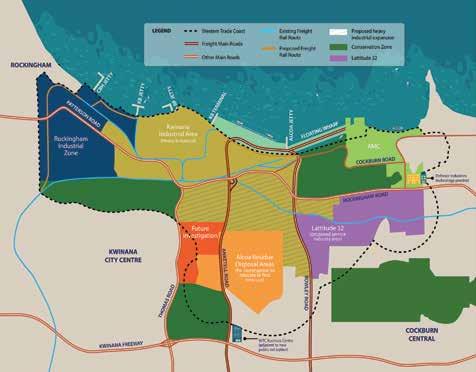
large cranes on the KIA skyline signals the emergence of many new major industrial complexes - a resurgence of activity! The AMC has its expansion plans approved and land availability for new development is diminishing across the AMC, KIA and RIZ.
NEW KWINANA PORT
Under the project management of the government’s Westport team, the new port in Kwinana is finally coming. The de-industrialisation of Fremantle and consequent movement of its freight task to the KIA is a major policy setting for the state government. Industry in Kwinana thoroughly supports the project because, among other reasons, the infrastructure planning for the new land-backed port resolves many of the WTC’s infrastructure constraints. While located on the opposite side of Cockburn Sound, the Royal Australian Navy will also have a deep interest in the proposed freight port. The configuration of its channels can greatly serve the strategic interests of Defence. It is proposed the existing single channel past Woodman Point northwards and out into the open ocean past Fremantle will be duplicated as part of the new port project. Together, Kwinana Industries Council, industry, Defence and Westport can achieve great things by working together to ensure the new port in Kwinana becomes a reality.
By Barry Sammels,
Mayor, City of Rockingham
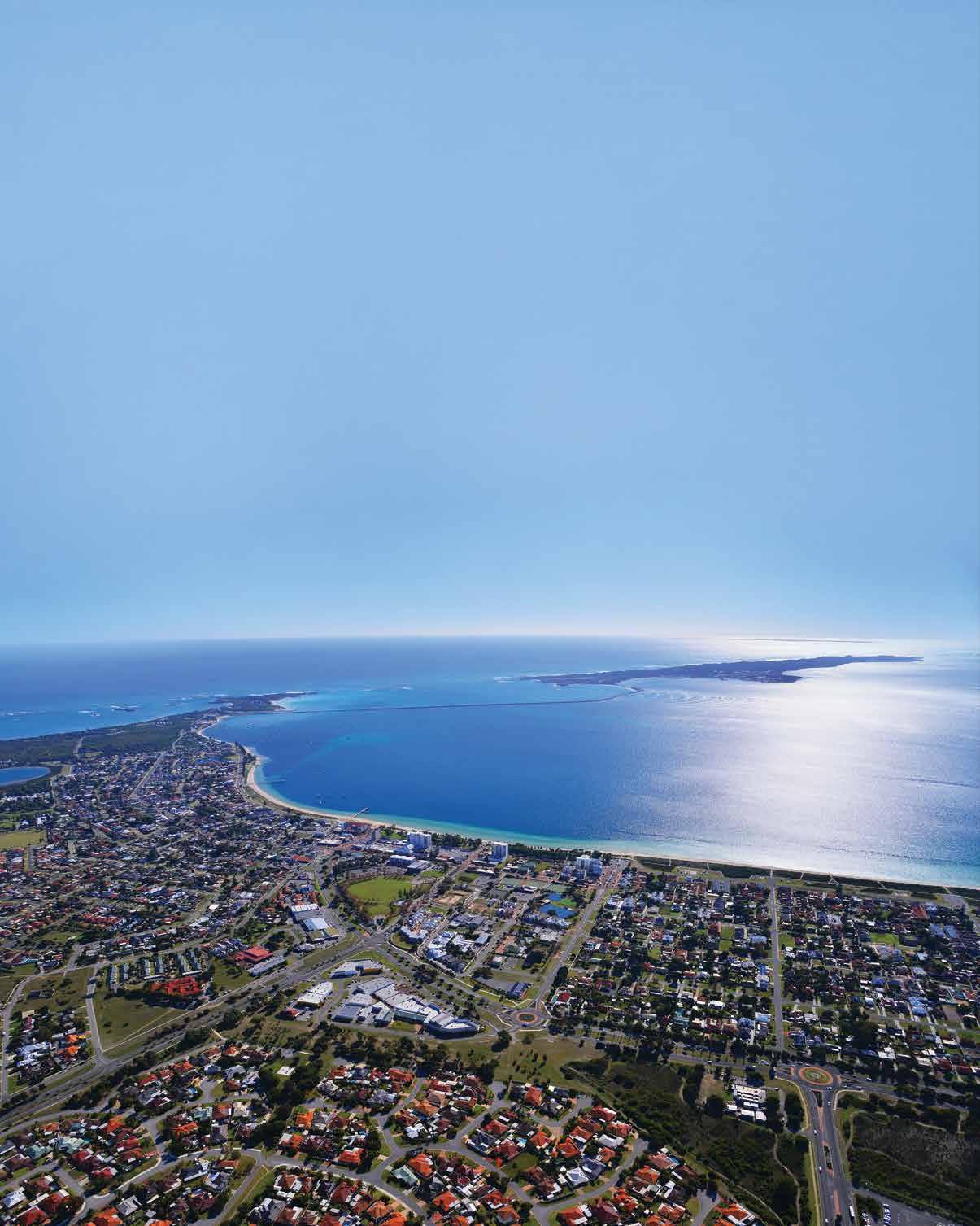

ROCKINGHAM: THE PLACE FOR DEFENCE INDUSTRY
Rockingham is well known as a destination for family holidays, adventure tourism, and as a place of natural beauty - think Penguin Island, the Shoalwater Islands Marine Park, or Cape Peron, recently announced as a Class A nature reserve. But did you know it is also home to a growing defence industry sector and some of Australia’s - and the world’s - largest names in the global defence supply chain?
Proximity to Fleet Base West at HMAS Stirling - the Royal Australian Navy’s largest shore establishment - is often cited as one of the key reasons businesses have located here. However, access to a growing and capable contingent of SME businesses, good connection to the Western Trade Coast, and a high quality coastal lifestyle are other attractors influencing businesses’ choice of Rockingham as their base in Western Australia.
HMAS Stirling at Fleet Base West is already home to more than 2650 service personnel, 600 Defence civilians and 500 long-term contractors, as well as all of Australia’s submarine fleet and up to half of the surface fleet. As part of the Navy Capability Infrastructure Sub-Program the base is in the midst of a $1bn expansion to accommodate the crews and facilities needed for the coming Arafura-class Offshore Patrol Vessels, Hunterclass frigates and future submarines.
Whether its businesses providing services in construction, maintenance, repair and refit for vessels, or Defence personnel, contractors and their families living on Garden Island or within our suburbs, Defence makes a significant contribution to the local economy.
In recognition of this contribution, the City of Rockingham actively supported local businesses to learn more about entering and working in the defence supply chain through a series of seminars in early 2021. Businesses in Rockingham were also briefed on upcoming opportunities and had the chance to network with each other, and with prime defence contractors and defence organisations, at Rockingham’s first Defence Industry Forum in April 2021. The city partnered with the Centre for Defence Industry Capability (CDIC) to present the forum, with key speakers including federal Minister for Defence Industry, Melissa Price MP, WA Minister for Small Business, Reece Whitby MLA, CASG Head of Maritime Systems RADM Wendy Malcolm, as well as other leaders from CDIC, Defence West, navy, Thales, Lendlease, Ventia, and the Australian Industry & Defence Network.
The city is investigating opportunities to establish a Defence Industry Hub in Rockingham. The proposed hub would be a high-quality business park for defence companies that encourages knowledge sharing, technology development, research and innovation. Proximity to Garden Island, the Australian Marine
Aerial image of Rockingham Industry Zone and HMAS Stirling, Fleet Base West. © DevelopmentWA. Complex in Henderson, Port of Fremantle, the proposed Westport development in Kwinana, and the Western Trade Coast, make Rockingham an ideal place to accommodate such a hub. Rockingham’s status as a strategic metropolitan centre with excellent transport links, freeway interchanges, two passenger rail stations, high population growth and a supportive business community make doing business in the proposed Defence Industry Hub appealing. These factors, coupled with attractively priced housing in a relaxed coastal setting, make relocation to the area very inviting. The concept of establishing an Indian Ocean maritime academy has also been suggested, with Rockingham identified as the ideal location. Utilising space at or near Murdoch University or South Metropolitan TAFE in the city’s campus sector, the facility would focus on training foreign navy and coast guard personnel from Indian Ocean maritime nations. The proposed education and training institution would complement and leverage Rockingham’s established education and defence industry sectors. The city recently launched its investment prospectus in June 2021, which focuses on attracting investment, supporting job creation and driving the economy forward. It outlines the opportunities in defence industry, as well as property development, general and heavy industry, tourism, aged care and retirement living. With the city’s population forecast to grow more than 70% to nearly 240,000 by 2046, Rockingham is truly a growing and thriving location for Defence and defence industry.
rockingham.wa.gov.au/defence
By Paddy Gregg,
CEO, Austal
A TRUE AUSTRALIAN DEFENCE PRIME: AUSTAL CHARTS SUCCESSFUL COURSE
Despite the challenges of the COVID-19 pandemic, Austal continued vessel production at all of our shipyards and achieved a record year for deliveries in FY2021, completing a total of 19 ships for commercial and defence customers worldwide - the most in our 33 years of shipbuilding.
A TEAM EFFORT
Here in Western Australia, we delivered seven defence vessels, including two Cape-class Patrol Boats exported to Trinidad and Tobago, and five steelhulled Guardian-class patrol boats for the Australia Government’s Pacific Patrol Boat Replacement Project (SEA3036). We also delivered two high-speed trimaran ferries, for customers in the Canary Islands and Japan. All designed and constructed here in WA.
Those impressive figures are testament to the skills, resilience and commitment of our Austal teams, our supply chain partners and the support of our customers, not only here in Australia but around the world.
Since 1988, we’ve been contracted to deliver more than 340 ships to 121 operators in 59 countries, and we’re not slowing down. Approximately 80% of our total production has been for overseas markets and operators, which is a fantastic export story for Australia.
Our robust FY2021 results, including an order book of over $2.5bn, provide an assurance we have a solid foundation to pursue new defence opportunities - domestically and overseas - in aluminium and steel. Over the past 12 months we have gained valuable insight from our customers and stakeholders throughout the world; helping us to continually improve our products and services, and better support

Austal Australia has designed and continues to manufacture both the 58m Cape-class patrol boat and 39.5m Guardian-class patrol boat for customers in Australia and around the world. These clients include the Australian Border Force, Royal Australian Navy, Trinidad and Tobago Coast Guard; and also the Australian Government, which is gifting from 2018 to 2023 21 Guardians to 12 Pacific-island nations and East Timor under the Pacific Patrol Boat Replacement Project (SEA3036 Phase 1). © Austal.
In FY2021 Austal Australia exported two 58m Cape-class patrol boats to the Trinidad and Tobago Coast Guard; a $126m project that has contributed to the growth of the WA’s defence industry and Australia’s sovereign naval shipbuilding capability. © Austal.

the organisations that rely on us. While we’ve identified areas of opportunity to improve, we’ve also learnt more about what we are doing well. BOON FOR DOMESTIC CAPABILITY
Austal is achieving great results for Australian industry capability in our current Evolved Cape and Guardian-class patrol boat programs – with the Pacific Patrol Boat Replacement Project named a finalist in the 2021 Essington Lewis Awards for excellence in defence projects over $50m.
Through effective collaboration with Defence and our efficient supply chain partners, we’re both on time and on budget with the 21 Guardian-class patrol boats we’re delivering for the Australian Government. These new vessels have quickly become the pride of the Pacific, with 12 delivered to Pacific island-nations since 2018.
We’re helping local Australian businesses achieve international success through our export programs, like the recent Cape-class patrol boats for the Trinidad and Tobago Coast Guard, and other massive opportunities like the Littoral Combat Ship and Expeditionary Fast Transport programs in the US. Companies like VEEM and Ayres, and many more small-to-medium enterprises have grown their business significantly through export contracts from Australia, to Austal shipyards around the world.
As an example, of the 1586 Australianbased suppliers engaged by Austal Australia over the past three years, 337 of those have exported approximately AUD$84m in goods and services to Austal’s shipyards in the Philippines and Vietnam, further developing Australia’s shipbuilding and export industry.
In Australia, Austal is employing more than 1000 people across four states and territories, including 120 apprentices and 28 graduates in WA alone. We’re a truly Australian defence prime – with a local head office and teams of skilled designers, engineers, tradespeople learning and developing innovative products and services here, in Australia. As an Australian stock exchange listed company, our profits stay here in Australia, for the benefit of our employees, suppliers, communities, customers and stakeholders.
Through the delivery of the Evolved Cape and Guardian-class programs, and our growing service and support operations, we’re proudly part of Australia’s continuous Naval Shipbuilding
Enterprise; comprising businesses from across Australian defence industry, investing in infrastructure and developing our people to provide both long-term security of employment for our growing national workforce, and delivering genuine sovereign capability.



By Terry Booth,
Special Correspondent, WA DEFENCE REVIEW
It is said that battles are won by generals, but wars are won by supply logistics. With Australia struggling through a multi-generational process to put a submarine in the water, there is probably no better time to talk about sovereign capability. On my recent visit to Hofmann Engineering, Erich J. Hofmann firmly advanced the view that we should keep defence work local.
A LEADER IN HEAVY INDUSTRY
“We could build a submarine in four to six months,” he said, as we stood against a backdrop of massive metal objects being bent, rolled, heat-treated, or finely machined to within a micron of specification. He knew exactly how Hofmann Engineering would do it too – construct the hull in three sections and deliver them to a shipyard to be consolidated and fitted-out.
The timeline came as a shock, but one doesn’t lightly dismiss the estimates of arguably one of Australia’s biggest high-end heavy engineering companies. This is especially so when you consider Hofmann Engineering has gotten the ADF out of some tight spots in the past - like the time they rescued five of the six Collins submarines from having their hulls cut open to access faulty generators. With typical ingenuity, the company devised a way of renovating in-situ, saving the taxpayer a fortune in the process. Similarly, when the army’s 800 Unimog trucks were at risk of being sidelined, they reverseengineered the gearbox and extended their lives.
“There is nothing we can’t build either from the plans, or reverse engineer from a sample,” Erich said, “and we may include improvements.” We glanced

Hofmann Engineering specialise in the design and manufacture of large mill and kiln girth gears up to 15m in diameter. The pictured gear, for a copper mill in China, had an external diameter of 13.2m and weighed in at 73.5t. © Hofmann Engineering.
Possessing an extensive collection of 5 axis machines, Hofmann Engineering cut a range of gears and worm wheels. Unique software is used to optimise the CAM program for the manufacture of these gears and wheels. © Hofmann Engineering.
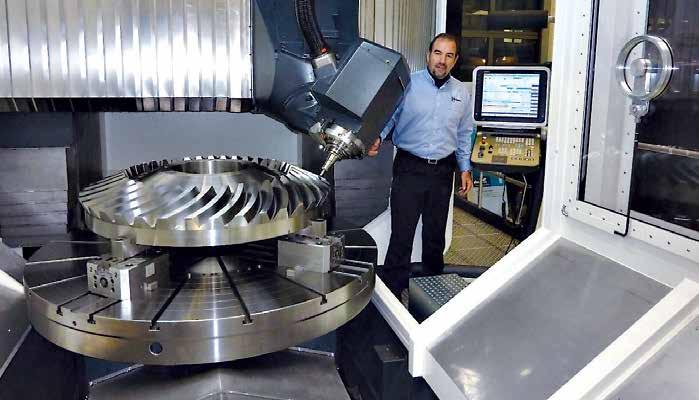
at a stack of mining track-pads nearby awaiting collection that could well have been for the Abrams tank. Why import from the US when you can make them here more cost effectively and to our own set of priorities?
Hofmann Engineering’s experience involves working the heaviest, thickest, hardest, and most difficult metals known to WA’s resources industry, as well as overhauling or manufacturing wheel motors for giant dump trucks. This heavy industry player has certainly earned the right to be confident about its ability to take on almost any engineering challenge.
INVESTMENT & DIVERSIFICATION
But there are broader reasons why Hofmann Engineering can lay claim to being a vital cog in the machinery of Australia’s sovereign capability. They are a leading-edge enterprise with their own R&D capacity, manufacturing from their own intellectual property on 80% of jobs. The company regularly invests in capital equipment and installs the latest automated machinery. They also recently bought up equipment from a Rolls Royce factory in Virginia,
USA – struck down by COVID-19 while
Hofmann Engineering were enjoying their best-ever year. They also expanded their network of sites constantly, both here and overseas.
A factor often cited against reliance on local industry is the so-called ‘valley of death’ where capability dissipates between Defence projects. For this company valleys can’t be seen for mountains as they have a full orderbook diversified across multiple industries and with production sites in several Australian and overseas locations. Fully half of its Australian product is exported, putting the company in an excellent position to weather economic storms lie ahead.
ESTABLISHED FAMILY BUSINESS
What of risks from being too highly geared financially? For Hofmann the problem does not exist. Since its foundation in a Perth backyard in 1969, the company has never borrowed; it operates and grows entirely with its own cash. What then of the risks of destabilising company takeovers? That too cannot happen, as the firm is fully family owned. What’s more, the family has implemented a legal instrument they call the ‘constitution’, a functionally binding document designed to ensure the continued success of the business for many generations to come.
But the focus on family in no way impedes the company’s recruitment and training - or the retention of good staff - as its constitution addresses employee policy in terms that inspire loyalty. As we spoke, one couldn’t help but notice a large area behind the Bassendean factory being prepared for four new full factory bays. No prizes for guessing the builder. “If we need anything, we make it ourselves,” Erich said, pointing to a pile of steel columns.
Home-grown companies like Hofmann Engineering play a vital and foundational role in Australia’s sovereign capability - there is much for the industry to learn from their ongoing success.
By Valerie Latimour, Contributing Defence Writer
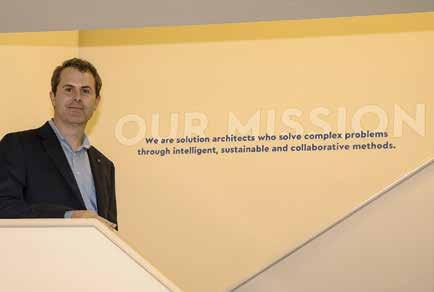
BRE ENGINEERING: MASTERMINDING PROJECTS FROM DESIGN TO DELIVERY
BRE Engineering is an engineering business with a difference. Founded in 2016 by Simon Brennan, BRE operates out of a purpose-built facility in Bibra Lake WA. With a 5-axis CNC router, 3D Printers, a 6-Axis ABB Robot, metallurgical lab and test facility, as well as 2D and 3D CAD systems and software, BRE has all the latest equipment and certification to provide engineering, design and manufacturing services in industries including mining, oil and gas, automation and defence.
In his previous position at a large company, Simon found the disconnect between design and build disheartening. Branching out on his own, he founded BRE Engineering, intent on allowing greater connection between design and build. Getting designers involved in the building stage allowed them to be more hands-on, and to correct and learn from issues as they arose, thereby increasing their knowledge and expertise for future designs.
In 2019 Simon positioned BRE to take advantage of the potential for business coming through the defence supply chain and shifted the company’s sales focus accordingly. In March 2019, BRE met with Henderson Alliance to commence the process of becoming part of the defence supply chain.
Several projects resulted, including the installation of vessel engine starters for Lürssen, fabrication of a 2.7t aluminium stern gate, fire suppression pressure vessel systems, lube oil tanks, and grey water pump set tanks. BRE are now the original equipment manufacturer for a number of organisations, providing overseas representation for those organisations on the vessels.
BRE’s Sydney team recently completed a project with Blohm + Voss, changing a 23t crankshaft on a vessel during lockdown. This difficult job was accomplished with great skill, earning BRE accolades. Another recent project involved working with CPB, a land-based prime contractor, on the design of an automatic aircraft rinse system for RAAF Base Pearce.
Simon Brennan is working tirelessly to make his vision for the future of BRE Engineering a reality. His interest lies not in growth simply for the sake of size, or multinational expansion; he is passionate about developing a business in WA, employing local people and using locally sourced and supplied products.
BRE is also focused on employing people who
© WA DEFENCE REVIEW. Photographer: David Nicolson. are under-privileged and under-represented in the industry. To this end BRE is working with Indigenous leaders to provide an apprenticeship program for young Indigenous people, focusing not only on training but also providing the participants with employment at the end of their training. BRE now has a range of capabilities across the life-span of a project, from the early design stages, engineering and certification, through to manufacture, building, testing and supply. With the addition of the marine services division of the business, these capabilities now extend to installation and maintenance for the life of the product. BRE offers all of its clients - including those in the defence supply chain – full turnkey solutions. Their experienced engineers, designers and builders can mastermind the entire project, reducing the need to engage multiple contractors and project managers. With innovative thinking and an ability to complete all aspects of the job, BRE will increase efficiency and reduce costs, while boosting the local economy - all while providing superior products and workmanship. BRE are absolute specialists in delivering elegant solutions to difficult problems.
bre.engineering
By Terry Booth,
Special Correspondent, WA DEFENCE REVIEW
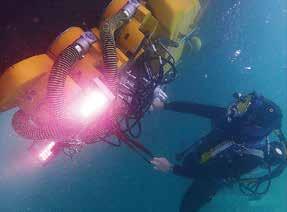
FRANMARINE UNDERWATER SERVICES: OUT OF SIGHT DOESN’T MEAN OUT OF MIND
It’s no surprise to find that WA’s successful industry cluster, the Australian Marine Complex, hosts companies delivering nation or world-leading performances. In the underwater marine technology field, Franmarine is a stand-out, having made innovations resulting in capabilities of sovereign importance.
As CEO, Adam Falconer-West explains, “Underwater ship husbandry - a consolidated underwater cleaning, inspection, maintenance and repair capability – is critical to Defence and is offered exclusively by Franmarine.”
In addition, effective biofouling (biological fouling) management, a subset of this capability is key to supporting Australia’s marine biosecurity objectives. Why is this important? Australia has one of the world’s strictest customs regimes, guarding against the entry of harmful biological matter into Australia from abroad. But there remains a gap in the system with the entry of biofouling acquired world-wide on ships’ hulls. Left unchecked this material has the potential to destroy beneficial undersea species, bringing health, economic and environmental loss – a consideration that is prompting re-evaluation of regulation, and increasing demand for cost-effective biofouling management techniques.
Falconer-West elaborates, saying “even during a three-month new build top side fit-out, while the hull is afloat in seawater, sufficient biofouling can develop on the underwater surfaces to measurably affect a vessel’s performance during sea trial. Biofouling adds drag to a hull, changing its responses and overall performance.”
Now commercialised under the name Envirocart, and marketed through the company CleanSubSea, the Franmarine innovation is an Australian solution to a world-wide problem. It is capable of 100% removal, capture, and containment of biofouling, using nonabrasive techniques. Its filtration system removes contaminants, particulates, and bio-fouling debris, then passes the water through a UV disinfection unit before discharge – effectively overcoming all the obstacles previously associated with this procedure.
The breakthrough came 10 years ago when the Department of Fisheries engaged Franmarine to develop a mobile front-line defence against non-indigenous, invasive marine species. The company delivered on Fisheries’ goals, then advanced the product further, meeting Australian and New Zealand standards and providing best practice guidance for other jurisdictions.
A company that can do that is likely to be cutting edge on other fronts, and so it is with Franmarine. The company also facilitates the delivery of consolidated ship’s husbandry using blockchain technology, meaning they can integrate with underwater hardware, such as a remotely operated vehicles and CCTV, to conduct real-time inspections of a ship’s hull, even if located overseas - all from their Henderson base. “We use the technology to provide increased visibility and access to the once completely foreign underwater worksite. We see this capability becoming an integral part of effective, transparent and traceable sustainment,” Falconer-West explained. “Another key benefit of the technology is that it provides for stronger collaboration, and in the case of the Royal Australian Navy we are looking forward to enabling collaboration to occur securely between Defence personnel and defence industry, during maintenance periods and active deployment.”
Franmarine’s nexus with the navy is growing year on year. In the last 12 months the company has established a base in Sydney to provide increased underwater in-service sustainment, to support the navy’s fleet. Its services are recognised as a sovereign industrial capability priority.
The company is engaged through prime contractor NSM to service three classes of ship - the frigate helicopter, the landing helicopter dock, and the light landing craft. As the subject capability is highly relevant to the navy’s surface fleet, Franmarine envisages supporting the navy more broadly with continuity and consistency of care to all the fleet.
What works for ships applies to any infrastructure standing in water, such as ports, wharves, jetties, pylons, and bridges - all benefit from Franmarine’s services. Clients also benefit from the company’s record-keeping and traceability procedures, supported by blockchain. The company’s objective is to lower the total cost of maritime asset ownership to its defence and industry partners. What is ‘out of sight’ to the user is never ‘out of mind’ when it’s in the care of Franmarine.
Franmarine diver performing in-water hull cleaning activities for Defence. © Franmarine.
INVESTING IN YOUR FUTURE: THE VESCIENT WAY
Vescient is an Australian veteran-owned business providing multi-disciplinary professional services and advice, including business strategy, portfolio, program and project delivery, engineering, procurement, asset management, and digital transformation. Vescient’s expertise and corporate experience enables them to solve problems through collaboration and application of cross-industry learnings.
Founded in 2016 by Rod Greedy, Dale Whelan and Bill Brannan, Vescient’s international client base has grown to include government agencies, multinational companies, and Australian small businesses. Vescient has delivered an impressive list of national and international projects, programs and portfolios across defence, resources, oil and gas, green energy, aviation and other sectors.
“We are often approached to solve the problems that others have not been able to,” says Dale Whelan, Managing Director of the company. “Within the modern business environment, many problems are rooted in complex relationships across people, process and systems. Our value proposition is our ability to identify and address root causes, and providing efficient business outcomes.”
Headquartered in Perth, Vescient has grown in both reputation and diversity of capability. Many clients continue to turn to Vescient for their pragmatic strategic advice, support in resolving complex problems and recovering distressed projects in situations where more traditional consultancies have been unable to deliver results.
Vescient is accessible to its public sector clients through standing offers via CASG DSS panel, Australian Federal Police, Digital Transformation Agency and state government panels and common use arrangements. The company’s strong defence pedigree in the areas of capability and intelligence operations has enabled the growth of aerospace, energy, cyber and integrated logistics capabilities. Vescient supports a number of large public and private clients to deliver outcomes in these complex domains.
On the ethos that drives their continued success, Dale remarks, “We genuinely take care of our Vescient family and form strong trusted personal relationships with our clients – we treat their business needs as our own. This is what enables us to integrate seamlessly and deliver what our clients need to achieve.” Dale says that their defence industry clients, including defence primes, “all benefit from our ability to leverage learnings and capability from non-defence industries.”
A current example of this is Vescient’s leading role in the design and build of Defence’s future processes and SAP ERP system for acquiring, operating and sustaining Defence assets. The company’s value to defence clients is enhanced by experience delivering similar processes for private sector clients. These cross-sector learnings have
Vescient Managing Director, Dale Whelan, and General Manager Peter Kershaw, visiting NUSHIP Stalwart at Garden Island during the final weeks of the ship’s fitout works, where Vescient provided health and safety assurance services to Asp Defence Support Services. © Vescient. also been used to improve safety performance for ship maintenance, integrated logistic support optimisation, project delivery assurance, mega infrastructure portfolio management, tendering support, and automation and technology systems integration. On Vescient’s future, Dale is upbeat, remarking “we will continue to grow an Australian iconic consulting company in more international markets and develop further into aerospace, energy, cyber and integrated logistics capabilities. Our focus in the Defence sector,” he adds, “will continue to support acquisition and sustainment of capability (CASG), infrastructure (E&IG) and information systems (CIOG). Additionally, our research and development of complex manufacturing solutions for sovereign capability will continue.” Asked what hurdles lie ahead for defence industry, Dale points out that defence industry will “need to achieve and maintain membership of the Defence Industry Security Program (DISP) at the business and supply chain level. Vescient achieved DISP certification in-house efficiently and within our existing ISO9001 and ISO27001 processes.” He sees “a lot of hype” in the market around DISP but notes “it can be achieved efficiently when considered in the context of your business and supply chain. It took only a few weeks of effort to design, draft and implement our DISP processes, and many businesses within the defence supply chain would be able to achieve a similar result with the right advice and support.” Finally, on Vescient’s advice for businesses seeking DISP membership, Dale offered these three tips: “Simple is effective, stick to the basics working within your existing management systems, and don’t allow yourself to become overwhelmed with requirements.”
vescient.com
